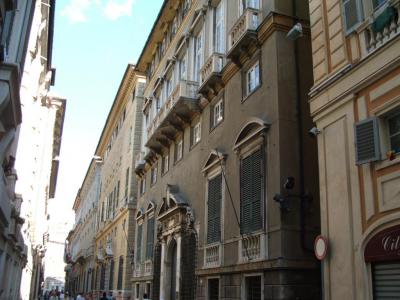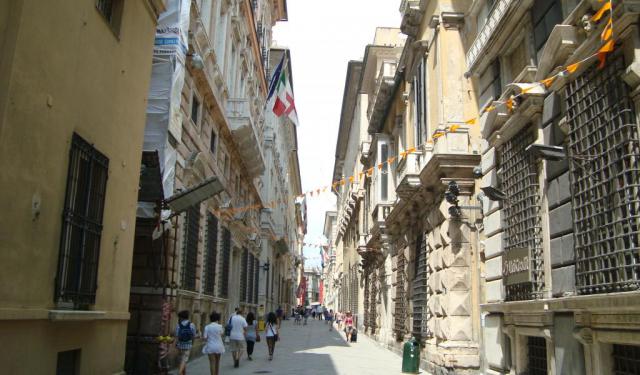
Palazzo Campanella (Bell Palace), Genoa
Palazzo Campanella, also known as Palazzo di Cristoforo Spinola or Palazzo Baldassarre Lomellini, is located at number 12 in Via Garibaldi. Construction of the palace was commissioned by Baldassarre Lomellini, banker to King Philip II of Spain, and was started in 1562 based on a design by Giovanni Ponzello, the architetto camerale ("chamber architect") of Genoa, who also created Palazzo Tursi belonging to Niccolò Grimaldi, Baldassarre's son-in-law.
Left of the original 16th-century façade now is only the white marble portal, created by Taddeo Carlone, inscribed "venturi non immemor aevi" (remember the years ahead). However, the whole original appearance of the palace can be seen in the engravings of Rubens made in 1622.
The palace changed ownership several times throughout the 16th century, eventually passing into the hands of the Marquis Cristoforo Spinola, Ambassador of the Republic of Genoa to France, who commissioned renovation of the property in the then nascent neoclassical style in 1773.
The most famous work of that period was the so-called Salone del Sole, a grandiloquent masterpiece of architecture and decoration, inspired by the palace of Versailles in France. It became one of the most prestigious destinations of the Grand Tour, remembered by Stendhal and Flaubert. Sadly, the hall was gutted by bombings in 1942, and whatever remained of the original decoration was later removed and never rebuilt.
In 1917, the palace was bought by Tito Campanella who established here an office and residence on the second floor. Today, the first floor is open to the public, where it is possible to see frescoes inspired by Roman motifs, painted by Andrea Semino. On the second floor there are more frescoes, by Giovanni Battista Castello "il Bergamasco", depicting Stories of Aeneas and Dido, and a 19th-century room created in Romantic style by Michele Canzio.
Left of the original 16th-century façade now is only the white marble portal, created by Taddeo Carlone, inscribed "venturi non immemor aevi" (remember the years ahead). However, the whole original appearance of the palace can be seen in the engravings of Rubens made in 1622.
The palace changed ownership several times throughout the 16th century, eventually passing into the hands of the Marquis Cristoforo Spinola, Ambassador of the Republic of Genoa to France, who commissioned renovation of the property in the then nascent neoclassical style in 1773.
The most famous work of that period was the so-called Salone del Sole, a grandiloquent masterpiece of architecture and decoration, inspired by the palace of Versailles in France. It became one of the most prestigious destinations of the Grand Tour, remembered by Stendhal and Flaubert. Sadly, the hall was gutted by bombings in 1942, and whatever remained of the original decoration was later removed and never rebuilt.
In 1917, the palace was bought by Tito Campanella who established here an office and residence on the second floor. Today, the first floor is open to the public, where it is possible to see frescoes inspired by Roman motifs, painted by Andrea Semino. On the second floor there are more frescoes, by Giovanni Battista Castello "il Bergamasco", depicting Stories of Aeneas and Dido, and a 19th-century room created in Romantic style by Michele Canzio.
Sight description based on Wikipedia.
Want to visit this sight? Check out these Self-Guided Walking Tours in Genoa. Alternatively, you can download the mobile app "GPSmyCity: Walks in 1K+ Cities" from Apple App Store or Google Play Store. The app turns your mobile device to a personal tour guide and it works offline, so no data plan is needed when traveling abroad.
Palazzo Campanella (Bell Palace) on Map






Sight Name: Palazzo Campanella (Bell Palace)
Sight Location: Genoa, Italy (See walking tours in Genoa)
Sight Type: Museum/Gallery
Guide(s) Containing This Sight:
Sight Location: Genoa, Italy (See walking tours in Genoa)
Sight Type: Museum/Gallery
Guide(s) Containing This Sight:
Walking Tours in Genoa, Italy
Create Your Own Walk in Genoa
Creating your own self-guided walk in Genoa is easy and fun. Choose the city attractions that you want to see and a walk route map will be created just for you. You can even set your hotel as the start point of the walk.
Genoa Introduction Walking Tour
Petrarch, an Italian poet of the early Renaissance known as the "father of humanism," called Genoa "La Superba" (The Proud One). Genoa is deservedly proud of her maritime glory and unique architecture.
From the 11th century until the late 18th century, the city became a leading economic and military power in Europe. It was one of the wealthiest cities in the world through... view more
Tour Duration: 2 Hour(s)
Travel Distance: 3.8 Km or 2.4 Miles
From the 11th century until the late 18th century, the city became a leading economic and military power in Europe. It was one of the wealthiest cities in the world through... view more
Tour Duration: 2 Hour(s)
Travel Distance: 3.8 Km or 2.4 Miles
Rolli Palaces Walking Tour
The Rolli di Genova – or, more precisely, the Rolli degli alloggiamenti pubblici di Genova (Italian for "Lists of the public lodgings of Genoa") – were first established in the Republic of Genoa in 1576. Originally, these official lists included private palaces and mansions belonging to the most distinguished local families, which - if chosen through a public lottery - were obliged... view more
Tour Duration: 1 Hour(s)
Travel Distance: 0.4 Km or 0.2 Miles
Tour Duration: 1 Hour(s)
Travel Distance: 0.4 Km or 0.2 Miles


